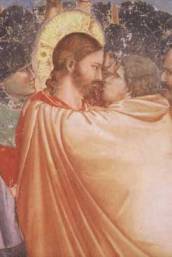As queer people, we practice the possibilities that are prohibited by society’s implicit and explicit ethical norms. The very word “bad” is derived from the Old English bœddel – a derogatory term for sodomites.[1]
 Giotto, The Judas Kiss, detail of fresco, 1305
Giotto, The Judas Kiss, detail of fresco, 1305
Ethical behaviour is traditionally based on obedience to a code of rules that defines virtue and prohibits vice. For centuries this code has contrived and derived from gender. A “good woman” and a “good man” are she and he who emphatically disavow a capacity for destabilizing the “natural functions” of their sex.
A complex sense of self, forged in social transformation and self-invention, informs an ethics that is peculiarly queer. For GLBTQ people, goodness does not arrive through silence and self-sacrifice. We gain strength and voice from others’ strength and voices. We give space to others when we invent and present ourselves. A queer form of altruism requires neither obedience nor subservience. Living for others is a creative choice, emerging through passions and pleasures. Living for self is not about winning power over others. It means using one’s singular voice, across its entire range, to sing the world to life. Care of an unstable, invented self is key to a richer notion of community, where new kinds of relationships become possible through being queer.
Shadow: Betrayal, self-loathing, revenge, the Judas kiss – alongside all the miracles and wonder of queer existence, these destructive patterns persist. How do people who have been so thoroughly associated with evil learn to be good to themselves and each other? With no sense of what is good and right that can embrace us, we can be demoralized. We can stay trapped in self-hatred and internalized homophobia. We can be deprived of spirit, courage and kindness. Or homosexuality can lead us through the fire, to a deeply ethical, yet radically open, way of living in the world.
Related Figures and Attributes: Evil, Hero, Perverse For more writing on this symbol, see these chapters of Orientation: Mapping Queer Meanings: Danger
[1] John Ayto, 1990 (48).


